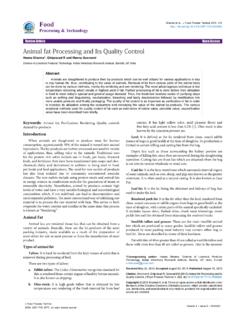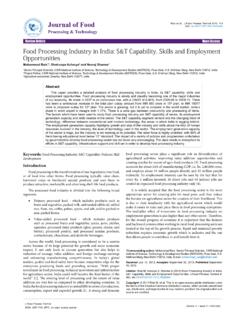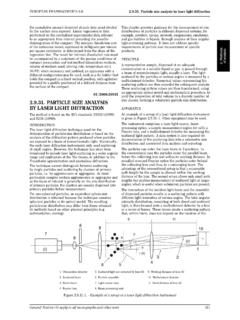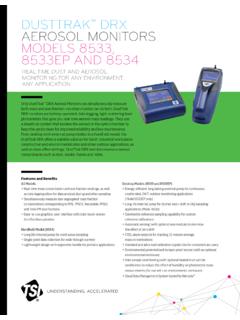Transcription of E Journal of Fundamentals of Renewable Energy
1 Research ArticleOpen AccessVolume 5 Issue 5 1000180J Fundam Renewable Energy ApplISSN: 2090-4541 JFRA, an open access Journal Trivedi, et al., J Fundam Renewable Energy Appl 2015, 5:5 DOI: : Myristic acid; Phase change materials; X-ray diffraction; thermal stability; Fourier transform infrared spectroscopy; Particle size analysisAbbreviation: XRD: X-ray diffraction; DSC: Differential scanningcalorimetry; TGA: Thermogravimetric analysis; DTA: Differential thermal analysis; DTG: Derivative thermogravimetry; FT-IR: Fourier transform infrared; PCMs: Phase change materialsIntroductionNowadays, the Energy consumption and production has considered as an interesting topic and debatable among researchers.
2 The demand for generation of newer Energy sources are increasing steadily day by day. This calls for design and development of novel Energy saving devices in order to reduce the consumption of Energy [1]. The enormous increase in production of greenhouse gases in atmosphere and elevation in cost of fossil fuel have caused researchers to develop more efficient thermal Energy storage devices. thermal Energy storage has grabbed significant attention worldwide for Energy conservation from the available sources of heat [2,3]. Phase change materials (PCM) are known as substance with high latent heat of fusion, which are capable of storing and releasing large amount of Energy whenever required.
3 Phase change materials (PCMs) are smart devices that can be utilized for thermal Energy storage. Moreover, form stable phase change PCMs are especially interesting due to high latent heat, shape stable and it can be directly used without encapsulation methods [4]. The materials used for fabricating the form stable solid-liquid PCMs are organic compounds such as paraffin [5], fatty acids [6], fatty alcohol [7,8], polyethylene glycol and their mixtures [9,10]. Fatty acids are commonly obtained from natural resources such as vegetable and animal oil products. These compounds have wide applicability in cosmetics, washing, environmental clean-up, *Corresponding author:Jana S, Trivedi Science Research Laboratory Pvt.
4 Ltd., Hall-A,Chinar Mega Mall, Chinar Fortune City, Hoshangabad Rd., Bhopal- 462026, MadhyaPradesh, India, Tel: +91-755-6660006; E-mail: August 03, 2015; Accepted August 20, 2015; Published August 27, 2015 Citation: Trivedi MK, Tallapragada RM, Branton A, Trivedi D, Nayak G et al. (2015) physical , spectroscopic and thermal characterization of Biofield treated Myristic acid. J Fundam Renewable Energy Appl 5: 180. : 2015 Trivedi MK, et al. This is an open-access article distributed under the terms of the Creative Commons Attribution License, which permits unrestricted use, distribution, and reproduction in any medium, provided the original author and source are acid has been extensively used for fabrication of phase change materials for thermal Energy storage applications.
5 The objective of present research was to investigate the influence of biofield treatment on physical and thermal properties of myristic acid. The study was performed in two groups (control and treated). The control group remained as untreated, and biofield treatment was given to treated group. The control and treated myristic acid were characterized by X-ray diffraction (XRD), Differential scanning calorimetry (DSC), Thermogravimetric analysis (TGA), Fourier transform infrared (FT-IR) spectroscopy, and Laser particle size analyzer. XRD results revealed alteration in intensity of peaks as well as significant increase in crystallite size ( ) of treated myristic acid with respect to control.
6 DSC study showed increase in melting temperature of treated myristic acid as compared to control. Nevertheless, significant change ( ) in latent heat of fusion ( H) was observed in treated myristic acid with respect to control. TGA analysis of treated myristic acid showed less weight loss ( ) as compared to control sample ( ). This may be due to increase in thermal stability of treated myristic acid in comparison with control. FT-IR results showed increase in frequency of CH2 and C=O stretching vibrations, probably associated with enhanced bond strength and force constant of the respective bonds. The particle size analyzer showed significant decrease in average particle size (d50 and d99) of treated myristic acid with respect to control.
7 Overall, the results showed significant alteration in physical , spectroscopic and thermal properties of myristic acid. The enhanced crystallite size, and thermal stability of treated myristic acid showed that treated myristic acid could be used as phase change material for thermal Energy storage applications.. physical , spectroscopic and thermal characterization of Biofield treated Myristic acidMahendra Kumar Trivedi1, Rama Mohan Tallapragada1, Alice Branton1, Dahryn Trivedi1, Gopal Nayak1, Rakesh K. Mishra2 and Snehasis Jana2* 1 Trivedi Global Inc., 10624 S Eastern Avenue Suite A-969, Henderson, NV 89052, USA2 Trivedi Science Research Laboratory Pvt.
8 Ltd., Hall-A, Chinar Mega Mall, Chinar Fortune City, Hoshangabad Rd., Bhopal- 462026, Madhya Pradesh, Indiaencapsulation and drug delivery [11]. Additionally, fatty acids possess excellent properties such as high phase change enthalpy and tunable phase change nature [12]. Myristic acid has recently showed great potential as solid-liquid PCMs for thermal Energy storage applications [13,14]. Hence, by considering the phase change property of myristic acid, authors decided to investigate the influence of biofield treatment on its physical , spectroscopic and thermal properties which can be further utilized for thermal storage applications. Fritz, has first proposed the law of mass- Energy interconversion and after that Einstein derived the well-known equation E=mc2 for light and mass [15,16].
9 Though, conversion of mass into Energy is fully validated, but the inverse of this relation, Energy into mass is not yet verified scientifically. Additionally, it was stated that Energy exist in various forms such as kinetic, potential, electrical, magnetic, nuclear etc. which have been generated from different sources. Similarly, neurons which are present in human brain have the ability to transmit the information in the form of electrical signals [17-20]. Thus, human beings have the ability to harness the Energy from environment/Universe and can transmit into any object (living or non-living) around the Globe. The Journal of Fundamentals of Renewable Energy and ApplicationsJournal of Fundamentals of Renewable Energy and ApplicationsISSN: 2090-4541 Citation: Trivedi MK, Tallapragada RM, Branton A, Trivedi D, Nayak G et al.
10 (2015) physical , spectroscopic and thermal characterization of Biofield treated Myristic acid. J Fundam Renewable Energy Appl 5: 180. 5 Issue 5 1000180J Fundam Renewable Energy ApplISSN: 2090-4541 JFRA, an open access Journal Page 2 of 6 Thermogravimetric analysis-differential thermal analysis (TGA-DTA) thermal stability of control and treated Myristic acid were analyzed by using Mettler Toledo simultaneous TGA and Differential thermal analyzer (DTA). The samples were heated from room temperature to 400 C with a heating rate of 5 C/min under air atmosphere. FT-IR spectroscopyFT-IR spectra were recorded on Shimadzu s Fourier transform infrared spectrometer (Japan) with frequency range of 4000-500 cm-1.

















